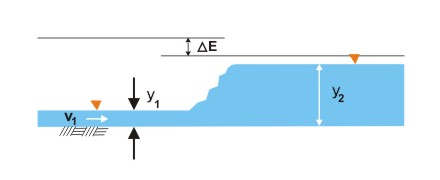The Hydraulic Jump
Today we are going to demonstrate
the hydraulic jump.
...
The hydraulic jump is an open-channel flow phenomenon by which the flow
passes suddenly from supercritical upstream of the jump, to subcritical downstream.
....
The hydraulic jump is formed in a horizontal channel when the headwater condition is sufficiently low and the
tailwater condition is sufficiently high.
...
The hydraulic jump always occurs with a loss of energy.
...
The formula for the energy loss is:
...
We turn on the pump.
....
We set the bed slope close to zero and check the level [Point to the level].
...
We raise the downstream water level until the hydraulic jump is established. [Wait to the jump to form]
...
Now we move the gage upstream to measure the upstream depth.
...
[Point to the gage]
Note that the point gage is at zero at the bottom of the flume.
...
We measure the upstream depth.
...
The upstream depth is: y1 mm.
...
Now we move the gage downstream to measure the downstream depth.
...
[Point to the gage]
Note that the point gage is at zero at the bottom of the flume.
...
We measure the downstream depth.
...
The downstream depth is: y2 mm
...
The energy loss due to the jump is:
...
ΔE = (y2 - y1)3 / (4 y1 y2)
ΔE = (y2 - y1)3 / (4 y1 y2)
